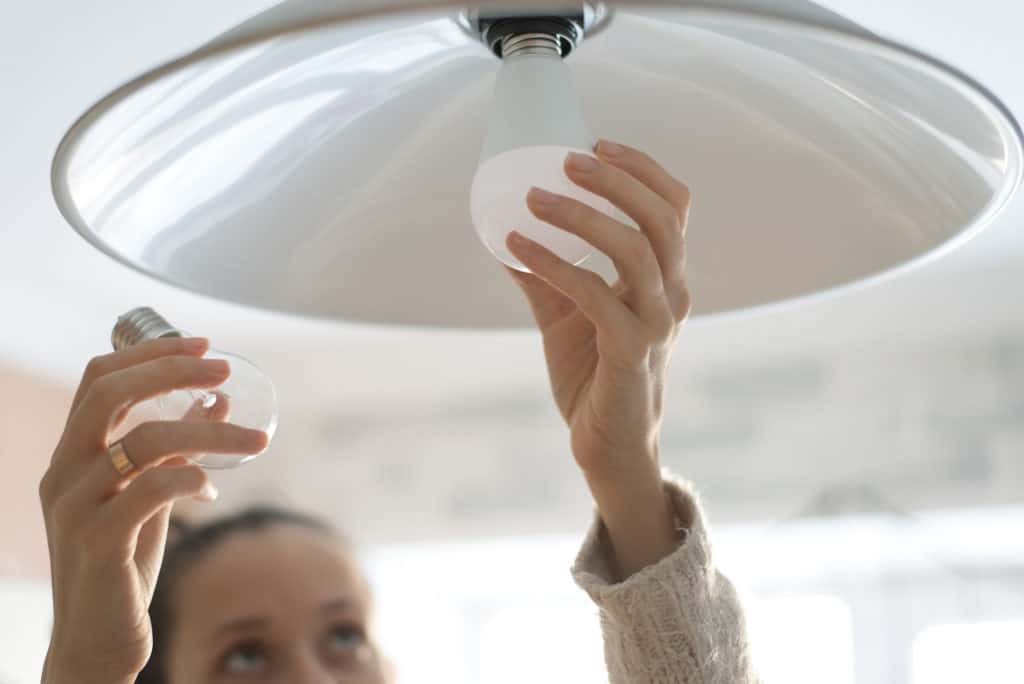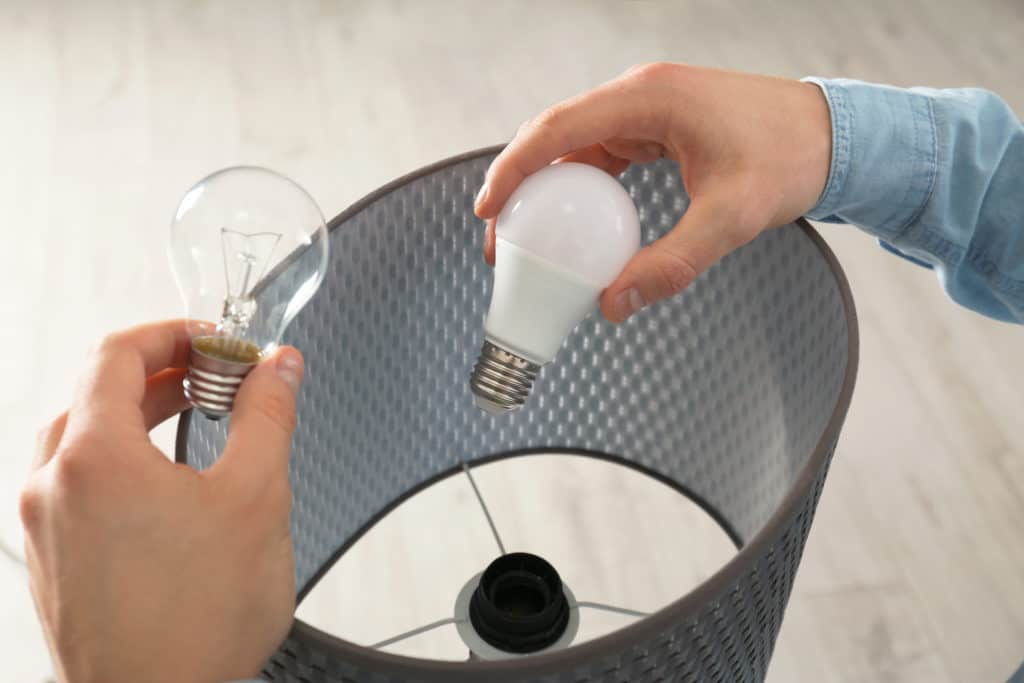LED lights have become wildly popular due to their energy-saving properties and the fact that they are more reliable than traditional incandescent light bulbs. Whenever carrying out an LED upgrade I’m often asked if LED bulbs can blow? This is a fair question to ask, after all, LEDs generate less heat than incandescent bulbs, so you would think that the LED bulb blowing is likely not to happen.
So, if you happen to be trying to figure out whether your LED bulbs can blow while in use – this quick guide will tell you if it does, explain what the cause is, give tips on how you can mitigate the risk, and how to avoid it from happening in the first place!

LED bulbs can blow. The most common reason for LED bulbs blowing is usually attributed to a tiny chip inside the lightbulb. This chip is responsible for converting the electricity from alternating current (AC) to direct current (DC). If this chip fails, a surge of electricity can blow the LED bulb
Can LED Bulbs Blow?
As we can see from the answer above, an LED bulb can blow. Although it is worth noting that it is unlikely to happen, and is a far less common occurrence than an incandescent bulb blowing.
Usually, the chip in the LED bulbs lasts a long time. However, suppose there is a fault with this chip due to a manufacturing error or damage during transit. In that case, it may cause a surge of electricity that can blow out the LED, resulting in the lightbulb blowing and potentially causing damage to any surrounding components.
As mentioned, once the chip has failed the AC electrical charge is then passed through the LED component which causes the damage. However, it’s worth knowing that the type of LED bulb you use is important and has an effect on the likely hood of the bulb blowing.
While it’s true that LEDs don’t generate as much heat, they still create more than other types of energy-efficient light bulbs currently on the market. An LED bulb blowing is more common with LED spotlights than bulbs because spotlights tend to contain multiple chips due to their higher output. I would always recommend buying good quality LED bulbs from established companies such as Sylvania lighting, linked to on Amazon here (opens a new tab)
What Causes LED Lights To Blow?
The leading cause of an LED light blowing is heat. As mentioned above, LEDs generate very little heat themselves, but the heat from the environment can build up inside the housing and damage internal components. This can shorten the lifespan of a bulb significantly
One estimate I read puts it at about 80 per cent shorter for every 10 degrees above recommended temperatures. Therefore, excessive heat buildup can affect other parts of the bulb’s internal construction. It can melt solder connections, which carry current from the circuitry to the LED chip, damaging them and causing a short circuit that may render the bulb useless.
Heat can also cause plastic parts within an LED bulb to become brittle and crack over time, exposing internal circuitry. For example, installing LED bulbs in fixtures without proper heat dissipation is not advised. This is especially true if you replace halogen MR16 or PAR bulbs with LED bulbs with comparable light output. These lighting applications typically do not have a cooling fan or other dissipating heat.
What Happens When an LED Light Blows?
When an led light blows up, it’s not the same way that old-fashioned light bulbs do. That’s why LED bulbs are so-called “LED bulbs” because they use light-emitting diodes. Diodes, unlike incandescent light bulbs, don’t blow in the traditional sense.
Diodes are special electrical components that allow current to flow through them in only one direction. If you put voltage on the wrong side of a diode, nothing happens. When you put it on the right side, the diode acts like a valve and allows electrons to flow through it. The electrons bump into each other as they pass through the diode and release energy in the form of photons – tiny packets of light.
This is how an LED works. As current passes through it, photons are released, and light appears. But because LEDs are solid-state devices – meaning they’re made up of a solid piece of material – they don’t have a filament that can burn out, glass that can shatter, or gas that can leak out. They gradually wear out as their components age and degrade from repeated use.
The fact that LED lights don’t produce as much heat is one reason they can be less alluring to spiders and other bugs. But even though LEDs don’t technically blow, they can fail for other reasons than just old age or normal wear and tear.

Reasons Why LED Bulbs Can Blow
- Voltage spikes: Too much voltage passing through an LED can kill it instantly. So if you install an LED bulb and a voltage surge occurs, it could be game over for your bulb. One way is by using bulbs with built-in surge protection (typically only found in commercial lighting products).
- Power surges: The same goes for power surges, which happen when a spike in electrical current flows through your home or business wiring and damaged electrical equipment through your utility lines. LEDs are more resistant to these than other bulbs because they don’t have filaments that can break during a surge. However, if the surge is big enough, it can blow out your LED lights.
- Vibration: LED light bulbs also won’t blow out from vibration like halogen and incandescent bulbs because they are much more solid-state in construction. The only way vibration would affect an LED bulb is if it was so severe that it knocked one of the electrical contacts loose inside its base. The vibrations don’t have to be extreme – just enough to hit the contacts lose over time so electricity no longer flows through them. This can happen, for example, in moving vehicles.
- Temperature: LEDs are sensitive to temperature changes and may not function properly at high or very low temperatures. In particular, cold weather can cause LEDs to a light dimmer than average until warmed up (which can take several minutes). However, some LEDs are better than others at handling temperature fluctuations. Again, this is where good qulaity LED bulbs come in like these Sylvania ones (Amazon link)
Do LED Light Bulbs Smell When They Blow?
LEDs don’t smell when they blow due to the way they are designed. A regular bulb blows because of a loose or disconnected filament that causes the element to overheat, melt and eventually fail. This can leave a strong odour of burning metal. On the other hand, LED bulbs have no filament or other moving parts that can fail catastrophically causing the burning smell.
In LED bulbs, rather than a filament-producing light, LEDs are simply semiconductors that emit light when powered. There’s no burning involved in their use; just an electronic reaction when power is applied through them. So as long as you’re not smelling anything from your LED lights, you don’t need to worry about them blowing any time soon.
How Can I Prevent an LED Bulb from Blowing?
There are a few precautions you can take to prevent your LED bulbs from blowing:
Make sure that the bulb’s watts match or are lower than the watts on your light fixture. If you’re replacing an incandescent bulb, your light fixture is probably rated for more watts than it ever actually used. But LED bulbs use less electricity, so you’ll need to check the rating to make sure.
Avoid using dimmer switches with LED bulbs. While many LED bulbs are designed to be used with dimmer switches, not all of them are, and using an incompatible bulb with a dimmer switch may cause both the bulb and the switch to malfunction. If you want to use a dimmer switch with LEDs, check that they are rated as compatible first.
Avoid using LED bulbs in enclosed fixtures. Some heat needs to be able to escape from an LED lightbulb for it to work properly. In an enclosed fixture – such as a recessed spotlight – this can prevent heat from escaping and shorten the life of your lightbulbs.
If in any doubt about the safety of your light fittings and fixtures it’s always best to ask an electrician to come round and check. I wrote an article linked here based on how long it would take an electrician to change a light fitting.
Conclusion
So, do LED light bulbs blow? LED bulbs are not susceptible to blowing like incandescent bulbs. However, they eventually burn out from a lifetime of use that can be measured in hours or days, depending on user exposure and environmental conditions. To minimize the risk of your LED bulb failing prematurely, buy high-quality brands, avoid leaving your lights on for extended periods, and turn them off when you aren’t using them.
